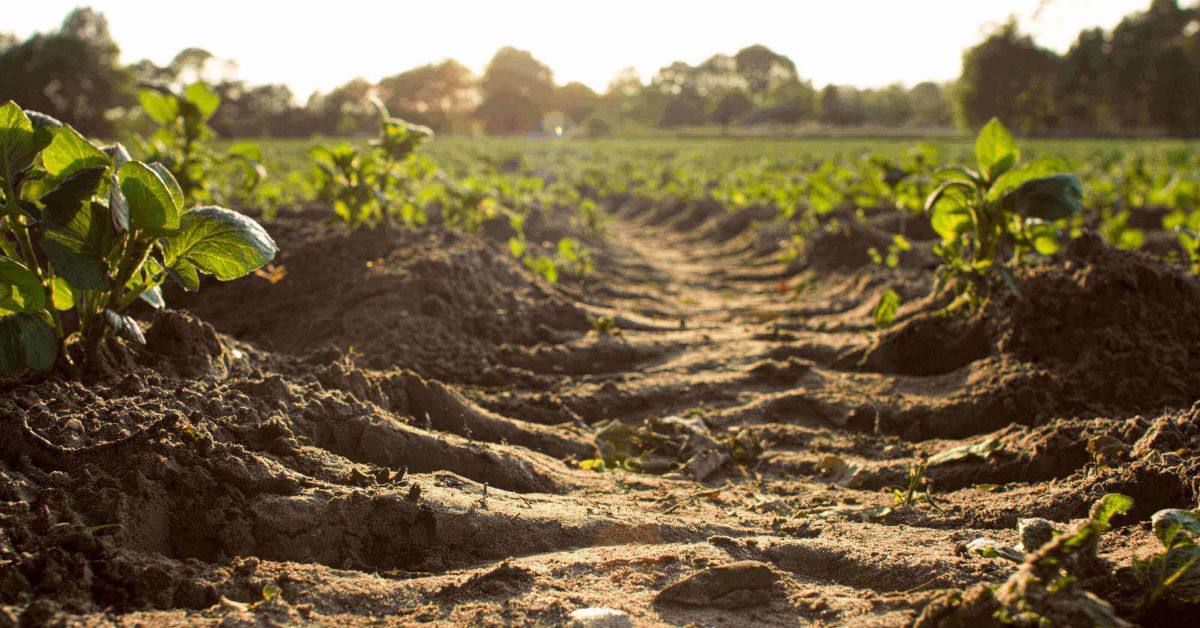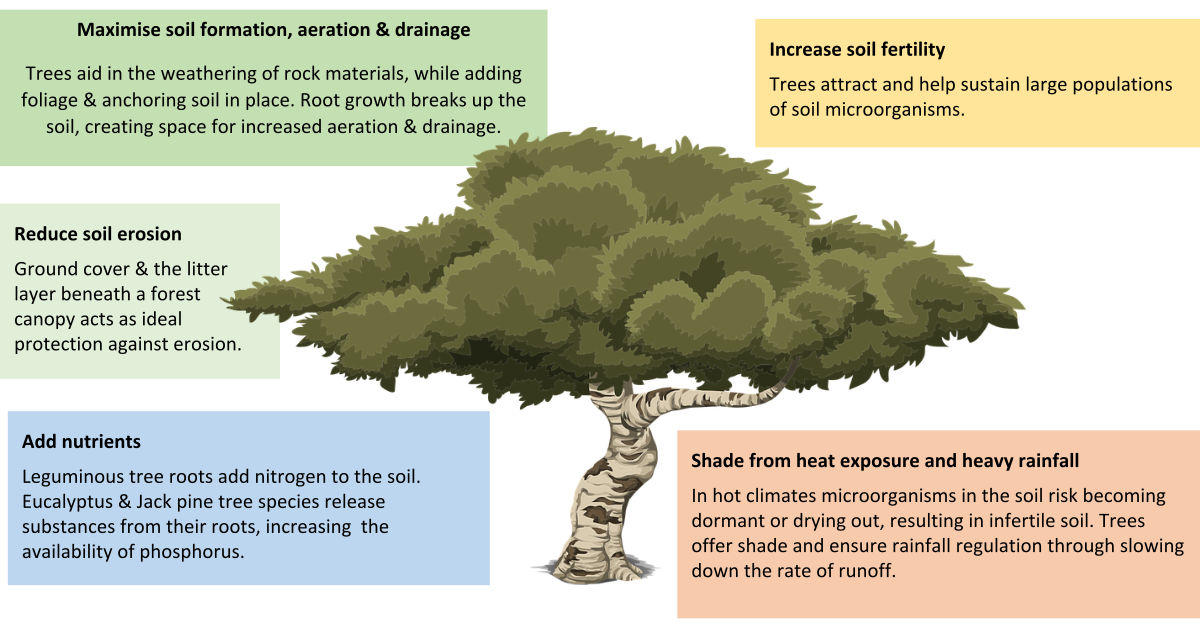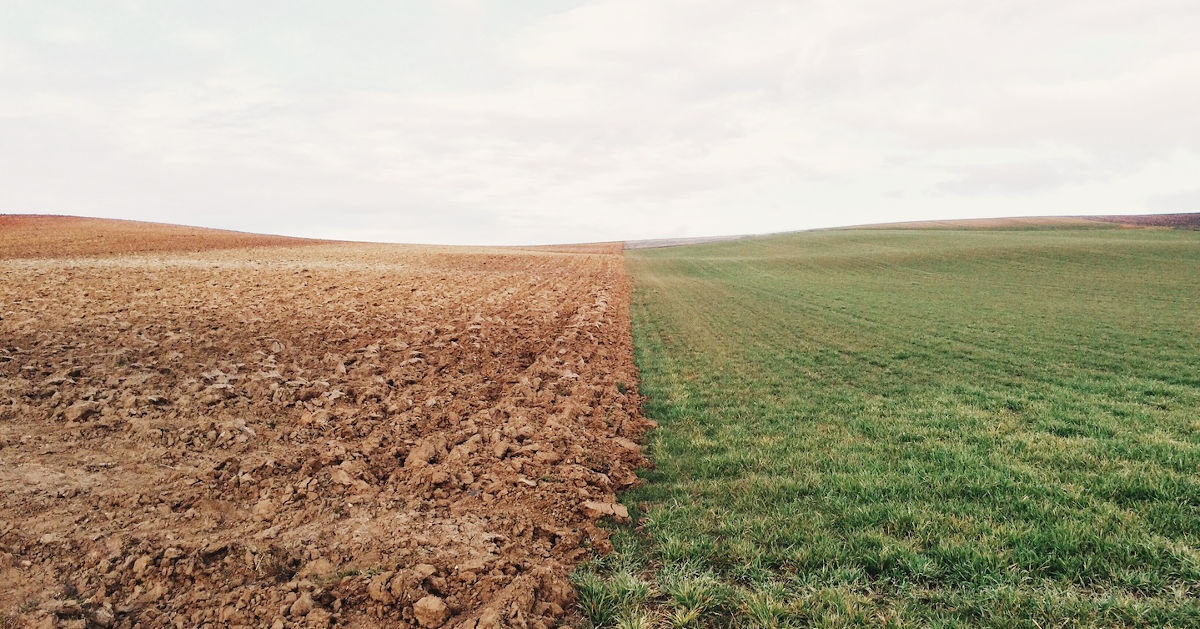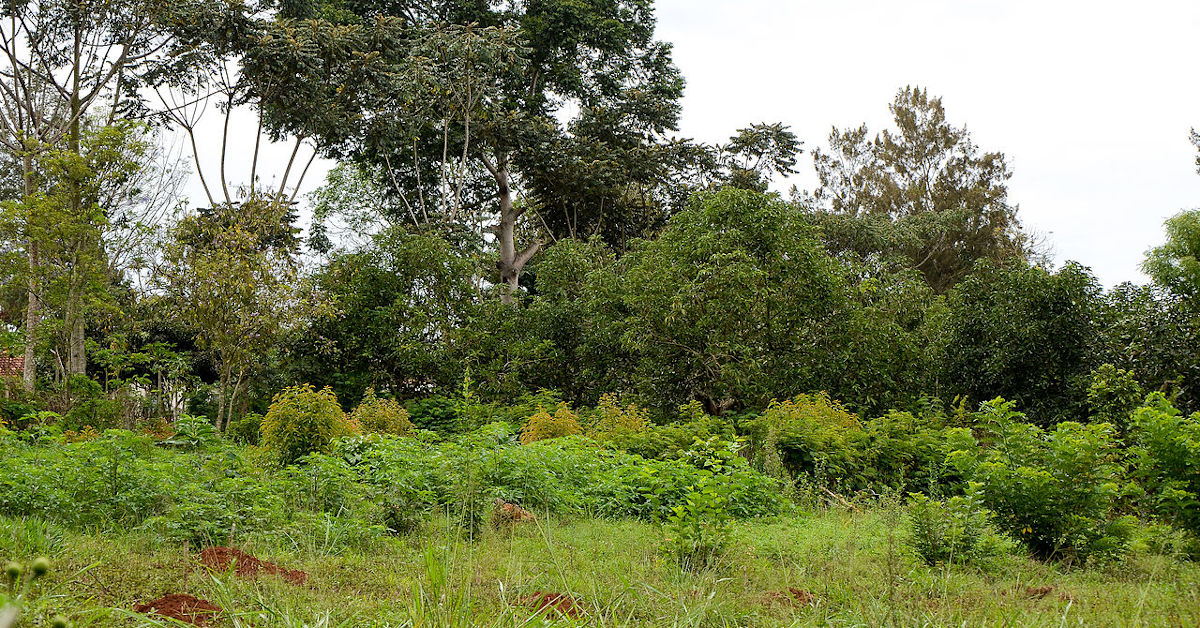The importance of healthy soil
Soil health describes the sustained capacity of soil to function as a living ecosystem, supporting plant, animal and human life [1]. Soil contains billions of bacteria, fungi and other microbes that are vital to soil fertility and ecosystem functioning [1]. Global soil biodiversity is estimated to be worth between US$1.5 and 13 trillion annually in terms of the value of ecosystems services it provides, including water services, provision of food and climate regulation [2].
Overall, soil health plays a key role in determining agricultural productivity, environmental resilience and ecosystem sustainability [9]. This is due to an ability of soil to store, cycle and transform nutrients, as well as providing a medium in which plant roots can become established [1]. Additionally, soil aids in rain, snowmelt and irrigation control, while filtering water and trapping any harmful pollutants that could go on to contaminate local water bodies [1].
Since land productivity is largely determined by soil health, land that has become degraded is made up of soil with low biodiversity and therefore fertility [2]. Fertile soil can take hundreds of years to form and can become easily eroded where biodiversity is low, reducing its ability to support crops and store water and carbon and resulting in the release of additional carbon emissions into the atmosphere [2]. It is estimated that 2 to 5 million hectares of arable land is lost to soil erosion annually and it’s estimated that if this extent of land degradation continues, we will see a 30% reduction in food production by 2040 [1]). Restoring soil biodiversity not only increases agricultural productivity but also has the potential to trigger at least half of the emission reductions required to limit the global average temperature increase to below 2°C above pre-industrial levels, as set out in the Paris Agreement [2].

Status in Kenya
Due to the variation in geology and climate, Kenya has a large variety of soils, which demonstrate low to high fertility. However, most of this soil is limited by salinity, acidity, fertility and drainage problems [3]. Poor soil fertility is characteristic of small-scale farms across Africa, with crop productivity growth failing to meet the demands of the growing population. Despite these issues, agriculture plays a huge role in the livelihoods of Kenyans, with food exports being a major source of employment and income [4].
Soil fertility in Kenya has dramatically reduced over the last decade. This is a consequence of considerable land degradation through ‘soil nutrient mining’, a process in which agricultural practices promote a negative nutrient balance, wind- and water-generated soil erosion, changes in vegetation diversity and structure, deforestation and desertification [5]. Loss of vegetation increases the frequency of wet-season flows, advancing erosion and sedimentation and resulting in increased nutrients running off into the water table. This excess runoff causes siltation, a process whereby water becomes contaminated by fine mineral particles, decreasing the clarity and quality of the water and maximising the cost of water treatment required to ensure the source is safe for human consumption [6].
Trees maintain and optimise soil health
Studies have demonstrated that agricultural systems that favour forests in terms of their canopy structure are less likely to experience soil erosion [8]. Crop production has been known to increase by 200% in most cases, as a result of the following benefits trees provide to optimise soil health. [7] [8].
Maximise soil formation, aeration and drainage
Forests contribute to the formation of soil by laying down roots that aid in the weathering of rock material, while adding foliage and anchoring soil in place. Adding organic content in the form of foliage allows the soil to hold more water, with every 1% increase holding a further 60,000 litres per acre [7]. Furthermore, the roots of trees improve the soil structure by acting as underground water channels, while root growth breaks up the soil, creating the space required for increased aeration and drainage [11].
Increase soil fertility
Trees attract and maintain large populations of microorganisms that live in the soil, through supplying additional organic matter, encouraging maximum soil biodiversity [16]. Carbon sugars are produced via the roots and obtained by microorganisms that supply trees with nutrients in return. This mutually beneficial relationship improves the soil quality since the more microorganisms that live in the soil, the more fertile the soil becomes [14].
Reduce soil erosion
Although soil erosion is a natural process, the rate at which it occurs is largely down to the amount of tree and plant cover in a given area. This vegetation offers defence against the wind and rain. Ground cover and the leaf litter layer beneath a forest canopy act as ideal protection against soil erosion [8]. Where vegetation has been removed, soil erosion becomes accelerated and the likeliness of flooding increases [10].
Supply nutrients
Some types of trees can enrich the soil with additional nutrients. Leguminous tree roots have the ability to add nitrogen to the soil via root nodules, supporting the growth of surrounding plants [11]. Meanwhile eucalyptus and Jack pine tree species release substances from their roots that increase the availability of phosphorus in the soil. These ‘fertiliser trees’ are being integrated with crop land across the globe due to their capacity to improve degraded soil conditions caused by continuous crop cycles that prevent the landscape from recovering [12].
Shade from heat exposure and heavy rainfall
Trees offer the soil protection from extreme sunlight exposure. This is especially important in hot climates where soil microorganisms risk becoming dormant or drying out, resulting in infertile soil [14]. Trees also ensure a more consistent supply of water to the soil by regulating rainfall, slowing down the rate of runoff in dry conditions while sheltering the soil from heavy rainfall, thus reducing erosion [19].
Trees protect the soil

Benefits of healthy soil for the local community
Trees stabilise soil erosion, increase aeration and water infiltration, while adding nutrients to the soil. Soils with higher organic matter content supplied by trees reduce the need for the use of fertilisers to produce crops. Pesticide and fertiliser use contributes to local air and water pollution, which can lead to a range of human health issues. Additionally, reducing their use results in fewer pollutants reaching and contaminating the water and lowers crop production costs for farmers [13].
A major cause of food insecurity across Africa is accelerated soil erosion and water runoff as a result of deforestation. Planting more trees will allow for higher crop yields in the presence of the same amount of rainfall [12]. Sustainably increasing agricultural production through carbon-friendly tree planting not only benefits farmers by cutting costs and making the land more resilient, it also boosts food security for the local community [13].

Impact on overall ecosystem health and other ecosystem services
Carbon sequestration
Behaviours that ensure long-term soil health, such as establishing and maintaining forest ecosystems, contribute to the capture and storage of atmospheric carbon. However, long-term global climate benefits are only achievable if the soil health is sustained through the preservation of forests [9].
Water cycle
Functional soil plays an important role in the supply of clean water and resilience to extreme weather such as droughts and floods (8). Through trapping pollutants before they can run off into the water table, soil naturally filters water present in aquifers and waterways for use by humans, plants and wildlife [8] [15]. This water filtration action also prevents ‘eutrophication’, a process by which a body of water becomes enriched by excess nutrients that promote the growth of aquatic plants. Excess plant growth depletes dissolved oxygen available to fish and other aquatic creatures, resulting in a loss in biodiversity [15].
Natural resources and biodiversity
Animals depend on healthy protected soil for their food to grow. Plants are a key source of food not only for herbivores and omnivores but for carnivores feeding on plant-consuming animals. The more vegetation that can grow in an area, the more individuals the ecosystem can support, enhancing biodiversity and therefore ecosystem functioning. Without healthy soil, plant cover would become too low to support animal populations, resulting in the starvation or migration of individuals [17].
Overall
Overall, tree planting could be the most effective and practical method of restoring soil fertility across the world. The carbon these soils could store and opportunity for the establishment of a variety of beneficial plants could ensure improved food security and a more stable and resilient climate for future generations.
References
1. https://www.nrcs.usda.gov/wps/portal/nrcs/main/soils/health/
2. https://www.iucn.org/resources/issues-briefs/conserving-healthy-soils
3. https://www.infonet-biovision.org/EnvironmentalHealth/Kenyan-Soils
4. https://www.nation.co.ke/oped/opinion/Poor-soil-health-making-Kenyans-hungry/440808-5029584-pnf606z/index.html
5. https://link.springer.com/chapter/10.1007/978-3-319-19168-3_16
6. https://www.unenvironment.org/news-and-stories/press-release/deforestation-costing-kenyan-economy-millions-dollars-each-year-and
7. https://isha.sadhguru.org/rally-for-rivers/how-trees-improve-soil-quality/
8. http://www.fao.org/3/u5620e/U5620E05.htm
9. https://food.berkeley.edu/wp-content/uploads/2017/08/BFI_Soil_Health_Report_June19.pdf
10. https://conservationgateway.org/Documents/cfop-chapter5.pdf
11. https://homeguides.sfgate.com/tree-roots-affect-soil-37932.html
12. https://commonpastures.org/news/trees-improve-the-soil/
13. https://foodfirst.org/wp-content/uploads/2017/04/SoilsCommunity_ExecSummary.pdf
14. https://www.youtube.com/watch?v=6mDVziX2Bg4
15. https://webcache.googleusercontent.com/search?q=cache:KCaNVJ0em6IJ:https://www.nrcs.usda.gov/wps/PA_NRCSConsumption/download%3Fcid%3Dnrcseprd1297288%26ext%3Dpdf+&cd=1&hl=en&ct=clnk&gl=uk
16. https://www.fas.scot/downloads/tn721-soil-biodiversity-and-soil-health/
17. https://fanimal.online/why-animals-need-soil/
18. https://theecologist.org/2015/aug/05/conserving-soil-precious-finite-and-under-threat
19. https://www.wri.org/blog/2017/03/3-surprising-ways-water-depends-healthy-forests
Alice O’Grady and The Team



